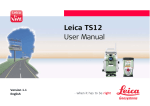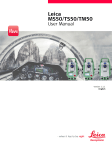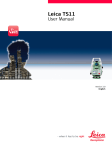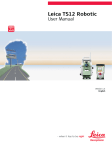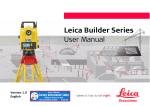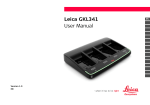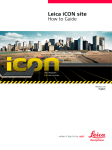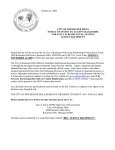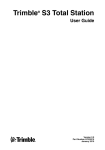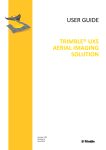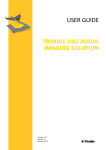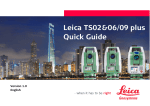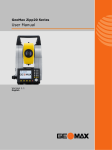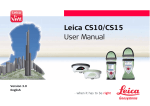Download Leica iCON robot 60/ iCON builder 60 User Manual
Transcript
Leica iCON robot 60/ iCON builder 60 User Manual Version 1.0 English Introduction Purchase Congratulations on the purchase of a Leica iCON robot 60/iCON builder 60. This manual contains important safety directions as well as instructions for setting up the product and operating it. Refer to "1 Safety Directions" for further information. Read carefully through the User Manual before you switch on the product. Product identification The type and serial number of your product are indicated on the type plate. Always refer to this information when you need to contact your agency or Leica Geosystems authorised service workshop. Trademarks • Windows is a registered trademark of Microsoft Corporation in the United States and other countries • Bluetooth® is a registered trademark of Bluetooth SIG, Inc. • SD Logo is a trademark of SD-3C, LLC. All other trademarks are the property of their respective owners. Validity of this manual This manual applies to the iCON robot 60/iCON builder 60 instruments. Differences between the various models are marked and described. Available documentation Name Description/Format iCON robot 60/iCON builder 60 Quick Guide Provides an overview of the product together with tech- nical data and safety directions. Intended as a quick reference guide. iCON robot 60/iCON builder 60 User Manual All instructions required in order to operate the product to a basic level are contained in the User Manual. Provides an overview of the product together with technical data and safety directions. Name Description/Format iCON build How to Guide, iCON site How to Guide Overall comprehensive guide to the product and applica- tion functions. Included are detailed descriptions of special software/hardware settings and software/hardware functions intended for technical specialists. Refer to the following resources for all iCON robot 60/iCON builder 60 documentation/software: • the Leica USB documentation card • https://myworld.leica-geosystems.com iCON robot 60/iCON builder 60, Introduction 2 myWorld@Leica Geosystems (https://myworld.leica-geosystems.com) offers a wide range of services, information and training material. With direct access to myWorld, you are able to access all relevant services whenever it is convenient for you, 24 hours a day, 7 days per week. This increases your efficiency and keeps you and your equipment instantly updated with the latest information from Leica Geosystems. Service Description myProducts Add all Leica Geosystems products that you and your company own. View detailed information on your products, buy additional options or Customer Care Packages (CCPs), update your products with the latest software and keep up-to-date with the latest documentation. myService View the service history of your products in Leica Geosystems Service Centres and detailed information on the services performed on your products. For your products that are currently in Leica Geosystems Service Centres view the current service status and the expected end date of service. mySupport Create new support requests for your products that will be answered by your local Leica Geosystems Support Team. View the complete history of your Support and view detailed information on each request in case you want to refer to previous support requests. myTraining Enhance your product knowledge with the Leica Geosystems Campus - Information, Knowledge, Training. Study the latest online training material or download training material on your products. Keep upto-date with the latest News on your products and register for Seminars or Courses in your country. myTrustedSer- Offers increased productivity while at the same time providing vices maximum security. • myExchange With myExchange you can exchange any files/objects from your computer to any of your Leica Exchange Contacts. • mySecurity If your instrument is ever stolen, a locking mechanism is available to ensure that the instrument is disabled and can no longer be used. iCON robot 60/iCON builder 60, Introduction 3 Table of Contents In this manual Chapter 1 Safety Directions 1.1 1.2 1.3 1.4 1.5 1.6 1.7 1.8 2 2.3 2.4 System Components System Concept 2.2.1 Software Concept 2.2.2 Power Concept 2.2.3 Data Storage Concept Container Contents Instrument Components User Interface 3.1 3.2 4 General Introduction Definition of Use Limits of Use Responsibilities Hazards of Use Laser Classification 1.6.1 General 1.6.2 Distancer, Measurements with Reflectors 1.6.3 Distancer, Measurements without Reflectors 1.6.4 Automatic Target Aiming ATR 1.6.5 PowerSearch PS 1.6.6 Electronic Guide Light EGL 1.6.7 Laser Plummet 1.6.8 Laser Guide Electromagnetic Compatibility EMC FCC Statement, Applicable in U.S. Description of the System 2.1 2.2 3 Page Keyboard Operating Principles Operation 4.1 4.2 4.3 4.4 4.5 4.6 4.7 4.8 4.9 4.10 Instrument Setup Connecting to a Personal Computer Remote Control Setup Power Functions Batteries 4.5.1 Operating Principles 4.5.2 Battery for the iCON robot 60/iCON builder 60 Instrument Operating the Laser Guide Working with the Memory Device Autodetect Behaviour LED Indicators Guidelines for Correct Results iCON robot 60/iCON builder 60, Table of Contents 6 6 7 7 8 8 11 11 11 12 14 14 15 15 17 18 19 21 21 23 23 23 24 24 26 28 28 29 30 30 31 33 33 34 34 34 35 35 36 37 37 4 5 Check & Adjust 5.1 5.2 5.3 5.4 5.5 5.6 5.7 6 TPS Specific Functionality within iCON site/iCON build 6.1 6.2 6.3 7 Transport Storage Cleaning and Drying Maintenance Technical Data 8.1 8.2 8.3 8.4 8.5 8.6 8.7 8.8 8.9 8.10 9 Machine Control Tools Settings Atack Care and Transport 7.1 7.2 7.3 7.4 8 Overview Preparation Combined Adjustment (l, t, i, c and ATR) Adjusting the Circular Level of the Instrument and Tribrach Adjusting the Circular Level of the Prism Pole Inspecting the Laser Plummet of the Instrument Servicing the Tripod Angle Measurement Distance Measurement with Reflectors Distance Measurement without Reflectors Automatic Target Aiming ATR PowerSearch PS Laser Guide Technical Data Conformity to National Regulations 8.7.1 iCON robot 60/iCON builder 60 8.7.2 CommunicationHandle General Technical Data of the Instrument Scale Correction Reduction Formulas Software Licence Agreement iCON robot 60/iCON builder 60, Table of Contents 39 39 40 41 43 43 44 45 46 46 47 48 50 50 50 51 51 52 52 52 53 54 56 56 57 57 58 58 61 64 66 5 1 Safety Directions 1.1 General Introduction Description The following directions enable the person responsible for the product, and the person who actually uses the equipment, to anticipate and avoid operational hazards. The person responsible for the product must ensure that all users understand these directions and adhere to them. About Warning Messages Warning messages are an essential part of the safety concept of the instrument. They appear wherever hazards or hazardous situations can occur. Warning messages... • make the user alert about direct and indirect hazards concerning the use of the product. • contain general rules of behaviour. For the users‘ safety, all safety instructions and safety messages shall be strictly observed and followed! Therefore, the manual must always be available to all persons performing any tasks described herein. DANGER, WARNING, CAUTION and NOTICE are standardized signal words for identifying levels of hazards and risks related to personal injury and property damage. For your safety it is important to read and fully understand the table below with the different signal words and their definitions! Supplementary safety information symbols may be placed within a warning message as well as supplementary text. Type DANGER WARNING CAUTION NOTICE Description Indicates an imminently hazardous situation which, if not avoided, will result in death or serious injury. Indicates a potentially hazardous situation or an unintended use which, if not avoided, could result in death or serious injury. Indicates a potentially hazardous situation or an unintended use which, if not avoided, may result in minor or moderate injury. Indicates a potentially hazardous situation or an unintended use which, if not avoided, may result in appreciable material, financial and environmental damage. Important paragraphs which must be adhered to in practice as they enable the product to be used in a technically correct and efficient manner. iCON robot 60/iCON builder 60, Safety Directions 6 1.2 Definition of Use Intended use • • • • • • • • Measuring horizontal and vertical angles. Measuring distances. Recording measurements. Automatic target search, recognition and -tracking. Visualising the aiming direction and vertical axis. Remote control of product. Data communication with external appliances. Computing with software. Reasonably forseeable misuse • • • • • Use of the product without instruction. Use outside of the intended use and limits. Disabling safety systems. Removal of hazard notices. Opening the product using tools, for example screwdriver, unless this is permitted for certain functions. Modification or conversion of the product. Use after misappropriation. Use of products with recognisable damages or defects. Use with accessories from other manufacturers without the prior explicit approval of Leica Geosystems. Inadequate safeguards at the working site. Aiming directly into the sun. Controlling of machines, moving objects or similar monitoring application without additional control- and safety installations. • • • • • • • WARNING Unauthorised modification of building and constructions machines by mounting or installing the product may alter the function and safety of the machine. Precautions: Follow the instructions of the machine manufacturer. If no appropriate instruction is available, ask machine manufacturer for instructions before mounting or installing the product. 1.3 Limits of Use Environment Suitable for use in an atmosphere appropriate for permanent human habitation: not suitable for use in aggressive or explosive environments. DANGER Environment Local safety authorities and safety experts must be contacted before working in hazardous areas, or close to electrical installations or similar situations by the person in charge of the product. Suitable for use in dry environments only and not under adverse conditions. iCON robot 60/iCON builder 60, Safety Directions 7 1.4 Responsibilities Manufacturer of the product Leica Geosystems AG, CH-9435 Heerbrugg, hereinafter referred to as Leica Geosystems, is responsible for supplying the product, including the user manual and original accessories, in a safe condition. Person responsible for the product The person responsible for the product has the following duties: • To understand the safety instructions on the product and the instructions in the user manual. • To ensure that it is used in accordance with the instructions. • To be familiar with local regulations relating to safety and accident prevention. • To inform Leica Geosystems immediately if the product and the application becomes unsafe. • To ensure that the national laws, regulations and conditions for the operation of e.g. radio transmitters or lasers are respected. WARNING This product must be installed on building and construction machinery only by an appropriately trained and qualified specialist. 1.5 Hazards of Use CAUTION DANGER NOTICE WARNING CAUTION Watch out for erroneous measurement results if the product has been dropped or has been misused, modified, stored for long periods or transported. Precautions: Periodically carry out test measurements and perform the field adjustments indicated in the user manual, particularly after the product has been subjected to abnormal use and before and after important measurements. Because of the risk of electrocution, it is dangerous to use poles and extensions in the vicinity of electrical installations such as power cables or electrical railways. Precautions: Keep at a safe distance from electrical installations. If it is essential to work in this environment, first contact the safety authorities responsible for the electrical installations and follow their instructions. With the remote control of products, it is possible that extraneous targets will be picked out and measured. Precautions: When measuring in remote control mode, always check your results for plausibility. If the product is used with accessories, for example masts, staffs, poles, you may increase the risk of being struck by lightning. Precautions: Do not use the product in a thunderstorm. During the operation of the product, there is a hazard of squeezing extremities or entanglement of hair and/or clothes by moving parts. Precautions: Keep a safe distance of the moving parts. iCON robot 60/iCON builder 60, Safety Directions 8 WARNING WARNING CAUTION CAUTION CAUTION WARNING WARNING CAUTION During dynamic applications, for example stakeout procedures there is a danger of accidents occurring if the user does not pay attention to the environmental conditions around, for example obstacles, excavations or traffic. Precautions: The person responsible for the product must make all users fully aware of the existing dangers. Inadequate securing of the working site can lead to dangerous situations, for example in traffic, on building sites, and at industrial installations. Precautions: Always ensure that the working site is adequately secured. Adhere to the regulations governing safety and accident prevention and road traffic. Be careful when pointing the product towards the sun, because the telescope functions as a magnifying glass and can injure your eyes and/or cause damage inside the product. Precautions: Do not point the product directly at the sun. If the accessories used with the product are not properly secured and the product is subjected to mechanical shock, for example blows or falling, the product may be damaged or people can sustain injury. Precautions: When setting-up the product, make sure that the accessories are correctly adapted, fitted, secured, and locked in position. Avoid subjecting the product to mechanical stress. During the transport, shipping or disposal of batteries it is possible for inappropriate mechanical influences to constitute a fire hazard. Precautions: Before shipping the product or disposing of it, discharge the batteries by running the product until they are flat. When transporting or shipping batteries, the person in charge of the product must ensure that the applicable national and international rules and regulations are observed. Before transportation or shipping contact your local passenger or freight transport company. High mechanical stress, high ambient temperatures or immersion into fluids can cause leakage, fire or explosions of the batteries. Precautions: Protect the batteries from mechanical influences and high ambient temperatures. Do not drop or immerse batteries into fluids. If battery terminals are short circuited e.g. by coming in contact with jewellery, keys, metalized paper or other metals, the battery can overheat and cause injury or fire, for example by storing or transporting in pockets. Precautions: Make sure that the battery terminals do not come into contact with metallic objects. Installing near mechanically moving machine components may damage the product. Precautions: Deflect the mechanically moving machine components as far as possible and define a safe installation zone. iCON robot 60/iCON builder 60, Safety Directions 9 CAUTION WARNING WARNING WARNING WARNING Beware of inadequate steering if machine is defective like after a crash or other damaging events or alterations to the machine. Precautions: Periodically perform control measurements and field adjustments on the machine as specified in the User Manual. While working, construction and grading should be checked by appropriate means, for example spirit level, tachymeter, before and after important measuring tasks. While steering or navigating the machine accidents can occur due a) the operator not paying attention to the surroundings (persons, ditches, traffic, etc.), or b) malfunctions (… of a system component, interference, etc.). Precautions: The operator assures that the machine is operated, guided and monitored by a qualified user (e.g. driver). The user has to be able to take emergency measures, for example an emergency stop. The following advice is only valid for AC adapters. If you open the product, either of the following actions may cause you to receive an electric shock. • Touching live components • Using the product after incorrect attempts were made to carry out repairs Precautions: Do not open the product. Only Leica Geosystems authorised service workshops are entitled to repair these products. The following advice is only valid for units equipped with ground connectors. If unit is not connected to ground, death or serious injury can occur. Precautions: To avoid electric shock power cable and power outlet must be grounded. The following advice is only valid for AC adapters and chargers. The product is not designed for use under wet and severe conditions. If unit becomes wet it may cause you to receive an electric shock. Precautions: Use the product only in dry environments, for example in buildings or vehicles. Protect the product against humidity. If the product becomes humid, it must not be used! iCON robot 60/iCON builder 60, Safety Directions 10 WARNING If the product is improperly disposed of, the following can happen: • If polymer parts are burnt, poisonous gases are produced which may impair health. • If batteries are damaged or are heated strongly, they can explode and cause poisoning, burning, corrosion or environmental contamination. • By disposing of the product irresponsibly you may enable unauthorised persons to use it in contravention of the regulations, exposing themselves and third parties to the risk of severe injury and rendering the environment liable to contamination. • Improper disposal of silicone oil may cause environmental contamination. Precautions: The product must not be disposed with household waste. Dispose of the product appropriately in accordance with the national regulations in force in your country. Always prevent access to the product by unauthorised personnel. Product-specific treatment and waste management information can be downloaded from the Leica Geosystems home page at http://www.leica-geosystems.com/treatment or received from your Leica Geosystems dealer. WARNING Only Leica Geosystems authorised service workshops are entitled to repair these products. 1.6 Laser Classification 1.6.1 General General The following chapters provide instructions and training information about laser safety according to international standard IEC 60825-1 (2007-03) and technical report IEC TR 60825-14 (2004-02). The information enables the person responsible for the product and the person who actually uses the equipment, to anticipate and avoid operational hazards. According to IEC TR 60825-14 (2004-02), products classified as laser class 1, class 2 and class 3R do not require: • laser safety officer involvement, • protective clothes and eyewear, • special warning signs in the laser working area if used and operated as defined in this User Manual due to the low eye hazard level. National laws and local regulations could impose more stringent instructions for the safe use of lasers than IEC 60825-1 (2007-03) and IEC TR 60825-14 (2004-02). 1.6.2 Distancer, Measurements with Reflectors General The EDM module built into the product produces a visible laser beam which emerges from the telescope objective. The product described in this section is classified as laser class 1 in accordance with: • IEC 60825-1 (2007-03): "Safety of laser products" • EN 60825-1 (2007-10): "Safety of laser products" These products are safe under reasonably foreseeable conditions of operation and are not harmful to the eyes provided that the products are used and maintained in accordance with this User Manual. iCON robot 60/iCON builder 60, Safety Directions 11 Labelling Description Value Maximum average radiant power 0.33 mW Pulse duration 800 ps Pulse repetition frequency (PRF) 100 MHz - 150 MHz Wavelength 650 nm - 690 nm Beam divergance 1.5 mrad x 3 mrad Class 1 Laser Product according to IEC 60825-1 Type: iCR6X Art.No.: 7900XX S.No.: Equip.No.: 1234567 Power: 12V / 7,4V ,1A max. Leica Geosystems AG CH-9435 Heerbrugg Manufactured: 20XX Made in Origin (2007 - 03) a 123456 Complies with FDA performance standards for laser products expect for deviations pursant to Laser Notice No. 50, dated June 24, 2007 This device complies with part 15 of the FCC Rules. Operation Is subject to the following two conditions: (1) This device may not cause harmful interference, and (2) this device must accept any interference received, including interference that may cause undesired operation. 006272_001 a) Laser beam 1.6.3 Distancer, Measurements without Reflectors General The EDM module built into the product produces a visible laser beam which emerges from the telescope objective. The laser product described in this section is classified as laser class 3R in accordance with: • IEC 60825-1 (2007-03): "Safety of laser products" • EN 60825-1 (2007-10): "Safety of laser products" Direct intrabeam viewing may be hazardous (low eye hazard level), in particular for deliberate ocular exposure. The beam may cause dazzle, flash-blindness and afterimages, particularly under low ambient light conditions. The risk of injury for laser class 3R products is limited because of: a) unintentional exposure would rarely reflect worst case conditions of (e.g.) beam alignment with the pupil, worst case accommodation, b) inherent safety margin in the maximum permissible exposure to laser radiation (MPE) c) natural aversion behaviour for exposure to bright light for the case of visible radiation. Description Value (R400/R1000) Maximum average radiant power 5.00 mW Pulse duration 800 ps Pulse repetition frequency (PRF) 100 MHz - 150 MHz Wavelength 650 nm - 690 nm Beam divergence 0.2 mrad x 0.3 mrad NOHD (Nominal Ocular Hazard Distance) @ 0.25s 80 m / 262 ft iCON robot 60/iCON builder 60, Safety Directions 12 CAUTION CAUTION From a safety perspective, class 3R laser products should be treated as potentially hazardous. Precautions: 1) Prevent direct eye exposure to the beam. 2) Do not direct the beam at other people. Potential hazards are not only related to direct beams but also to reflected beams aimed at reflecting surfaces such as prisms, windows, mirrors, metallic surfaces, etc. Precautions: 1) Do not aim at areas that are essentially reflective, such as a mirror, or which could emit unwanted reflections. 2) Do not look through or beside the optical sight at prisms or reflecting objects when the laser is switched on, in laser pointer or distance measurement mode. Aiming at prisms is only permitted when looking through the telescope. Labelling Laser Aperture a Laser Radiation Avoid direct eye exposure Class 3R Laser Product according to IEC 60825-1 (2007 - 03) Po 5.00 mW = 650-690 nm 006273_001 a) Laser beam Type: iCR6X Art.No.: 7900XX S.No.: Equip.No.: 1234567 Power: 12V / 7,4V ,1A max. Leica Geosystems AG CH-9435 Heerbrugg Manufactured: 20XX Made in Origin 123456 Complies with FDA performance standards for laser products expect for deviations pursant to Laser Notice No. 50, dated June 24, 2007 This device complies with part 15 of the FCC Rules. Operation Is subject to the following two conditions: (1) This device may not cause harmful interference, and (2) this device must accept any interference received, including interference that may cause undesired operation. 006274_001 iCON robot 60/iCON builder 60, Safety Directions 13 1.6.4 Automatic Target Aiming ATR General The Automatic Target Aiming built into the product produces an invisible laser beam which emerges from the telescope objective. The product described in this section is classified as laser class 1 in accordance with: • IEC 60825-1 (2007-03): "Safety of laser products" • EN 60825-1 (2007-10): "Safety of laser products" These products are safe under reasonably foreseeable conditions of operation and are not harmful to the eyes provided that the products are used and maintained in accordance with this User Manual. Labelling Description Value Maximum peak power 10 mW Pulse duration 11 ms Pulse repetition frequency (PRF) 37 Hz Wavelength 785 nm Class 1 Laser Product according to IEC 60825-1 Type: iCR6X Art.No.: 7900XX S.No.: Equip.No.: 1234567 Power: 12V / 7,4V ,1A max. Leica Geosystems AG CH-9435 Heerbrugg Manufactured: 20XX Made in Origin (2007 - 03) 123456 Complies with FDA performance standards for laser products expect for deviations pursant to Laser Notice No. 50, dated June 24, 2007 This device complies with part 15 of the FCC Rules. Operation Is subject to the following two conditions: (1) This device may not cause harmful interference, and (2) this device must accept any interference received, including interference that may cause undesired operation. a 006272_001 a) Laser beam 1.6.5 PowerSearch PS General The PowerSearch built into the product produces an invisible laser beam which emerges from the front side of the telescope. The product described in this section is classified as laser class 1 in accordance with: • IEC 60825-1 (2007-03): "Safety of laser products" • EN 60825-1 (2007-10): "Safety of laser products" These products are safe under reasonably foreseeable conditions of operation and are not harmful to the eyes provided that the products are used and maintained in accordance with this User Manual. Description Value Wavelength 850 nm Maximum average radiant power 11 mW Pulse duration 20 ns, 40 ns iCON robot 60/iCON builder 60, Safety Directions 14 Labelling Description Value Pulse repetition frequency (PRF) 24.4 kHz Beam divergance 0.4 mrad x 700 mrad Class 1 Laser Product according to IEC 60825-1 Type: iCR6X Art.No.: 7900XX S.No.: (2007 - 03) a Equip.No.: 1234567 Power: 12V / 7,4V ,1A max. Leica Geosystems AG CH-9435 Heerbrugg Manufactured: 20XX Made in Origin 123456 Complies with FDA performance standards for laser products expect for deviations pursant to Laser Notice No. 50, dated June 24, 2007 This device complies with part 15 of the FCC Rules. Operation Is subject to the following two conditions: (1) This device may not cause harmful interference, and (2) this device must accept any interference received, including interference that may cause undesired operation. 006275_001 a) Laser beam 1.6.6 Electronic Guide Light EGL General The Electronic Guide Light built into the product produces a visible LED beam which emerges from the front side of the telescope. The product described in this section, is excluded from the scope of IEC 608251 (2007-03): "Safety of laser products". The product described in this section, is classified as exempt group in accordance with IEC 62471 (2006-07) and does not pose any hazard provided that the product is used and maintained in accordance with this user manual. a b TS_099 a) LED beam red b) LED beam yellow 1.6.7 Laser Plummet General The laser plummet built into the product produces a visible red laser beam which emerges from the bottom of the product. The laser product described in this section is classified as laser class 2 in accordance with: • IEC 60825-1 (2007-03): "Safety of laser products" • EN 60825-1 (2007-10): "Safety of laser products" These products are safe for momentary exposures but can be hazardous for deliberate staring into the beam. The beam may cause dazzle, flash-blindness and after-images, particularly under low ambient light conditions. iCON robot 60/iCON builder 60, Safety Directions 15 CAUTION Description Value Wavelength 650 nm - 690 nm Maximum average radiant power 0.95 mW Pulse duration c.w. Pulse repetition frequency (PRF) c.w. Beam divergance <1.5 mrad From a safety perspective, class 2 laser products are not inherently safe for the eyes. Precautions: 1) Avoid staring into the beam. 2) Avoid pointing the beam at other people. Labelling Type: iCR6X Art.No.: 7900XX S.No.: Equip.No.: 1234567 Power: 12V / 7,4V ,1A max. Leica Geosystems AG CH-9435 Heerbrugg Manufactured: 20XX Made in Origin 123456 Complies with FDA performance standards for laser products expect for deviations pursant to Laser Notice No. 50, dated June 24, 2007 This device complies with part 15 of the FCC Rules. Operation Is subject to the following two conditions: (1) This device may not cause harmful interference, and (2) this device must accept any interference received, including interference that may cause undesired operation. Laser Radiation Do not stare into the beam Class 2 Laser Product according to IEC 60825-1 (2007 - 03) a Po 1.00 mW = 620 - 690 nm 006277_001 a) Will be replaced by a class 3R warning label if applicable b a 006278_001 a) Laser beam b) Exit for laser beam iCON robot 60/iCON builder 60, Safety Directions 16 1.6.8 Laser Guide General The Laser Guide built into the iCON robot 60/iCON builder 60 G instrument produces a visible red laser beam which emerges from the front side of the telescope. The laser product described in this section is classified as laser class 3R in accordance with: • IEC 60825-1 (2007-03): "Safety of laser products" • EN 60825-1 (2007-10): "Safety of laser products" Direct intrabeam viewing may be hazardous (low eye hazard level), in particular for deliberate ocular exposure. The beam may cause dazzle, flash-blindness and afterimages, particularly under low ambient light conditions. The risk of injury for laser class 3R products is limited because of: a) unintentional exposure would rarely reflect worst case conditions of (e.g.) beam alignment with the pupil, worst case accommodation, b) inherent safety margin in the maximum permissible exposure to laser radiation (MPE) c) natural aversion behaviour for exposure to bright light for the case of visible radiation. CAUTION CAUTION Description Value (R400/R1000) Maximum radiant power 4.75 mW Pulse duration c.w. Pulse repetition frequency c.w. Wavelength 650 nm - 690 nm Beam divergence 0.1 mrad NOHD (Nominal Ocular Hazard Distance) @ 0.25s 112 m / 367 ft From a safety perspective, class 3R laser products should be treated as potentially hazardous. Precautions: 1) Prevent direct eye exposure to the beam. 2) Do not direct the beam at other people. Potential hazards are not only related to direct beams but also to reflected beams aimed at reflecting surfaces such as prisms, windows, mirrors, metallic surfaces, etc. Precautions: 1) Do not aim at areas that are essentially reflective, such as a mirror, or which could emit unwanted reflections. 2) Do not look through or beside the optical sight at prisms or reflecting objects when the laser is switched on, in laser pointer or distance measurement mode. Aiming at prisms is only permitted when looking through the telescope. iCON robot 60/iCON builder 60, Safety Directions 17 Labelling Type: iCR6X Art.No.: 7900XX S.No.: Equip.No.: 1234567 Power: 12V / 7,4V ,1A max. Leica Geosystems AG CH-9435 Heerbrugg Manufactured: 20XX Made in Origin 123456 Complies with FDA performance standards for laser products expect for deviations pursant to Laser Notice No. 50, dated June 24, 2007 This device complies with part 15 of the FCC Rules. Operation Is subject to the following two conditions: (1) This device may not cause harmful interference, and (2) this device must accept any interference received, including interference that may cause undesired operation. 006274_001 1.7 Electromagnetic Compatibility EMC Description The term Electromagnetic Compatibility is taken to mean the capability of the product to function smoothly in an environment where electromagnetic radiation and electrostatic discharges are present, and without causing electromagnetic disturbances to other equipment. WARNING Electromagnetic radiation can cause disturbances in other equipment. Although the product meets the strict regulations and standards which are in force in this respect, Leica Geosystems cannot completely exclude the possibility that other equipment may be disturbed. CAUTION CAUTION CAUTION There is a risk that disturbances may be caused in other equipment if the product is used with accessories from other manufacturers, for example field computers, personal computers or other electronic equipment, non-standard cables or external batteries. Precautions: Use only the equipment and accessories recommended by Leica Geosystems. When combined with the product, they meet the strict requirements stipulated by the guidelines and standards. When using computers or other electronic equipment, pay attention to the information about electromagnetic compatibility provided by the manufacturer. Disturbances caused by electromagnetic radiation can result in erroneous measurements. Although the product meets the strict regulations and standards which are in force in this respect, Leica Geosystems cannot completely exclude the possibility that the product may be disturbed by intense electromagnetic radiation, for example, near radio transmitters, two-way radios or diesel generators. Precautions: Check the plausibility of results obtained under these conditions. If the product is operated with connecting cables attached at only one of their two ends, for example external supply cables, interface cables, the permitted level of electromagnetic radiation may be exceeded and the correct functioning of other products may be impaired. Precautions: While the product is in use, connecting cables, for example product to external battery, product to computer, must be connected at both ends. iCON robot 60/iCON builder 60, Safety Directions 18 1.8 WARNING WARNING FCC Statement, Applicable in U.S. The greyed paragraph below is only applicable for products without radio. This equipment has been tested and found to comply with the limits for a Class B digital device, pursuant to part 15 of the FCC rules. These limits are designed to provide reasonable protection against harmful interference in a residential installation. This equipment generates, uses and can radiate radio frequency energy and, if not installed and used in accordance with the instructions, may cause harmful interference to radio communications. However, there is no guarantee that interference will not occur in a particular installation. If this equipment does cause harmful interference to radio or television reception, which can be determined by turning the equipment off and on, the user is encouraged to try to correct the interference by one or more of the following measures: • Reorient or relocate the receiving antenna. • Increase the separation between the equipment and the receiver. • Connect the equipment into an outlet on a circuit different from that to which the receiver is connected. • Consult the dealer or an experienced radio/TV technician for help. Changes or modifications not expressly approved by Leica Geosystems for compliance could void the user's authority to operate the equipment. Labelling iCON robot 60/iCON builder 60 Type: iCR6X Art.No.: 7900XX S.No.: Equip.No.: 1234567 Power: 12V / 7,4V ,1A max. Leica Geosystems AG CH-9435 Heerbrugg Manufactured: 20XX Made in Origin 123456 Complies with FDA performance standards for laser products expect for deviations pursant to Laser Notice No. 50, dated June 24, 2007 This device complies with part 15 of the FCC Rules. Operation Is subject to the following two conditions: (1) This device may not cause harmful interference, and (2) this device must accept any interference received, including interference that may cause undesired operation. 006274_001 Labelling internal battery GEB222 005043_001 Labelling internal battery GEB212 005044_001 iCON robot 60/iCON builder 60, Safety Directions 19 Labelling RadioHandle RH1200 Type: RH1200 Art.No.: 741964 Power: 7.4V/12V nominal / 0.2A max. 100mW EIRP Leica Geosystems AG CH-9435 Heerbrugg Manufactured: 20XX Made in Switzerland Contains Transmitter Module: FCC ID: HSW-2400M S.No.: 1234567 This device complies with part 15 of the FCC Rules. Operation is subject to the following two conditions: (1) This device may not cause harmful interference, and (2) this device must accept any interference received, including interference that may cause undesired operation. 006222_001 RH15 Type: RH15 Art.No. : 772300 Power: 7.4V/12.5V / 0.2A max. Leica Geosystems AG CH-9435 Heerbrugg Manufactured: 20xx Made in Switzerland Contains Transmitter Module: FCC ID: HSW-2400M IC: 4492A-2450 S.No.: 1234567 This device complies with part 15 of the FCC Rules. Operation is subject to the following two conditions: (1) This device may not cause harmful interference, and (2) this device must accept any interference received, including interference that may cause undesired operation. S.No.: 1234567 This device complies with part 15 of the FCC Rules. Operation is subject to the following two conditions: (1) This device may not cause harmful interference, and (2) this device must accept any interference received, including interference that may cause undesired operation. 006836_001 CCD2 Type: CCD2 Art.No. : 790051 Power: 7.4V/12.5V / 0.2A max. Leica Geosystems AG CH-9435 Heerbrugg Manufactured: 20xx Made in Switzerland Contains Transmitter Module: FCC ID: HSW-2400M IC: 4492A-2450 006279_001 iCON robot 60/iCON builder 60, Safety Directions 20 2 Description of the System 2.1 System Components System components iCR60 iCS60 CC50 CC60 006280_001 Main components Component Description iCON robot 60/iCON builder 60 instrument • a total station for measuring, calculating and capturing data. • consisting of various models with a range of accuracy classes. • combined with the multi-purpose CC55/CC60/CC65/CC61/ CC66 field controller to conduct remote control surveys. Laser Guide • The iCON robot 60 equipped with Automatic Target Aiming. Instruments equipped with the Laser Guide cannot be equipped with PowerSearch (PS) or Guide Light (EGL). • included in a special compartment in the upper telescope section. • emits a visible red laser beam used for visualising the line of sight. • used for targeting of inaccessible objects or prohibited surfaces; positioning of objects and inspecting marks on surfaces. CC50/CC55/CC60/CC65 A multi-purpose field controller enabling the remote control field controller of the iCON robot 60/iCON builder 60 via short range Bluetooth. CC61/CC66 or CC50/CC51 with CCD3 Terms and abbreviations A multi-purpose field controller enabling the remote control of iCON robot 60 via long range Bluetooth. The following terms and abbreviations can be found in this manual: Term Description RCS Remote Control Surveying EDM Electronic Distance Measurement EDM refers to the laser distancer incorporated into the instrument which enables distance measurement. Two measuring modes are available: • Prism mode. This mode refers to the ability to measure distances to prisms. • Reflectorless mode. This mode refers to the ability to measure distances without prisms. PinPoint PinPoint refers to the Reflectorless EDM technology which enables an increased measuring range with a smaller laser spot size. Three options are available: R30, R400 and R1000. iCON robot 60/iCON builder 60, Description of the System 21 Term Description EGL Electronic Guide Light An EGL fitted to an instrument assists with prism targeting. It consists of two differently coloured flashing lights located in the instrument telescope housing. The person holding the prism can align themselves into the line of sight of the instrument. Motorised Instruments fitted with internal motors, enabling automatic horizontal and vertical turning are referred to as Motorised. ATR Automated Target Aiming. ATR refers to the instrument sensor which enables the automatic target aiming to a prism. Automated Refers to the instrument sensor which enables the automatic target aiming to a prism. Three automation modes are available: • Single Manual: No automation and no lock. • Single Auto: Automatic target aiming to a prism. • Continuous with lock: Automatic tracking of an already targeted prism. PowerSearch PowerSearch refers to the instrument sensor which enables the automatic rapid finding of a prism. Communication- A component of RCS is the RH1200/RH15/CCD2 CommunicationHandle Handle. It is an instrument carry handle with an integrated radio modem with attached antenna. Communication side cover Communication side cover with integrated Bluetooth, SD card slot and USB port is standard for a iCON robot 60/iCON builder 60 instrument. In combination with the RH1200/RH15/CCD2 CommunicationHandle, it is also a component of RCS. Machine Control Application Enables optimal communication between iCON robot 60 and 3D Machine Control Systems. To carry out machine calibration and alignment routines when used with Leica 3D Paving Systems. Setup Pilot A method to carry out the setup of the iCON robot 60 to a number of existing control points in a fully automated way. Cube Search A method to optimise the prism search. Creates a cube-shaped search window around the position where the prism was lost. Dynamically , the search window is updated and adjusted in size depending on the distance between prism and iCON robot 60. Target Snap A prism search method. Snaps to the desired prism by ignoring other prisms, which are known from the database. iCON robot 60/iCON builder 60, Description of the System 22 2.2 System Concept 2.2.1 Software Concept Description All instruments use the same software concept. Software Software upload Software type Description System software This software comprises the central functions of the instrument. It is also referred to as firmware. Application program It is recommended to control the instrument with Leica Geosystems field software. Refer to the respective software manual for more information. Uploading software can take some time. Ensure that the battery is at least 75% full before beginning the upload, and do not remove the battery during the upload process. Software for Description iCON robot 60/iCON builder 60 The iCON software is stored in the flash RAM of the iCON robot 60/iCON builder 60. Software update instructions • Download the most recent iCON robot 60/iCON builder 60 firmware file from https://myworld.leica-geosystems.com. • Insert the SD card into the computer. • Copy the iCON robot 60/iCON builder 60 firmware file into the \SYSTEM folder on the SD card. If no \SYSTEM folder is available, then create the folder first. • Take the SD card out of the computer and insert SD Card into the instrument. • Start the iCON robot 60/iCON builder 60 and the iCON software. • Tap on Systems. • Tap on FW Update. • Select the firmware file. • Tap to start the firmware update. • A message will appear when the upload is complete. 2.2.2 Power Concept General Use the batteries, chargers and accessories recommended by Leica Geosystems to ensure the correct functionality of the instrument. Power options Model Power supply iCON robot 60/iCON Internally by GEB221/GEB222 battery, OR builder 60 Externally by GEV52 cable and GEB171 battery. If an external power supply is connected and the internal battery is inserted, then the external power is used. iCON robot 60/iCON builder 60, Description of the System 23 2.2.3 Data Storage Concept Description Data is stored on a memory device. The memory device can be an SD card or internal memory. For data transfer an USB stick can also be used. Memory device SD card: USB stick: Internal memory: Transfer data All instruments have an SD card slot fitted as standard. An SD card can be inserted and removed. Available capacity: 8 GB. All instruments have a USB port fitted as standard. All instruments have an internal memory fitted as standard. Available capacity: 1 GB. While other SD cards can be used, Leica Geosystems recommends to only use Leica SD cards and is not responsible for data loss or any other error that can occur while using a non-Leica card. Unplugging connecting cables or removing the SD card or USB stick during the measurement can cause loss of data. Only remove the SD card or USB stick or unplug connecting cables when the iCON robot 60/iCON builder 60 instrument is switched off. Data can be transferred in various ways. Refer to "4.2 Connecting to a Personal Computer". SD cards can directly be used in an OMNI drive as supplied by Leica Geosystems. Other PC card drives can require an adaptor. 2.3 Container Contents Container contents for iCON builder 60 part 1 of 2 a h b i c j d e k f l g 006281_001 a) b) c) d) e) f) g) h) i) j) k) l) GLS115 mini prism pole GFZ3 diagonal eyepiece Allen key and adjustment tool Instrument GAD105 flat or mini prism adapter GEB221/GEB222 battery MS1 Leica industrial grade USB memory stick GPR105 double sided reflector Protective cover for instrument, sunshade for objective lens and cleaning cloth Manuals & USB documentation card Point adapter for GLS115 mini prism pole Counterweight for diagonal eyepiece iCON robot 60/iCON builder 60, Description of the System 24 Container contents for iCON builder 60 part 2 of 2 p q m r n s t o u 006282_001 m) GKL211 battery charger n) Car adapter cable for battery charger o) GEB221/GEB222 battery p) GEV267 USB data transfer cable q) GLI115 Clip-on bubble for GLS115 mini prism pole r) GHT196 holder for height meter s) GHM007 height meter t) GEV223 USB data cable u) CPR111 Builder prism, true-zero offset Container contents for iCON robot 60 part 1 of 2 a g b h c d i e f j 006283_001 a) b) c) d) e) f) g) h) i) j) GEV223 USB data cable GFZ3 diagonal eyepiece Counterweight for diagonal eyepiece Protective cover for instrument, sunshade for objective lens and cleaning cloth Instrument Allen key and adjustment tool GMP101 mini prism GHT196 holder for height meter Manuals & USB documentation card GEB221/GEB222 battery iCON robot 60/iCON builder 60, Description of the System 25 Container contents for iCON robot 60 part 2 of 2 k o l p m n 006284_001 k) Spare stylus l) Car adapter cable for battery charger m) Pocket knife n) SD cards and covers o) GKL211 battery charger p) MS1 Leica industrial grade USB memory stick 2.4 Instrument Components Instrument components part 1 of 2 a b c de f g i h j 006285_001 iCON robot 60/iCON builder 60, Description of the System a) Carry handle b) Optical sight c) Telescope, integrating EDM, ATR*, EGL, PS* d) EGL flashing diode - yellow and red e) PowerSearch, transmitter f) PowerSearch, receiver g) Overview camera h) Coaxial optics for angle and distance measurement, and exit port of visible laser beam for distance measurements i) Communication side cover j) Horizontal drive * Optional 26 Instrument components part 2 of 2 a b d e c f g h i j 006286_001 a) b) c) d) e) f) g) h) i) j) Focusing ring Interchangeable eyepiece Circular level Vertical drive Battery compartment Footscrew Tribrach Touch screen Keyboard Stylus for touch screen a) b) c) d) e) Compartment lid USB stick cap storage USB device port (mini AB OTG) USB host port for USB stick SD card port Communication side cover a b c d e 006287_001 Instrument components for RCS Available for iCON robot 60. a d 006288_001 iCON robot 60/iCON builder 60, Description of the System a) CommunicationHandle b) Communication side cover 27 3 User Interface 3.1 Keyboard Keyboard Keys ab c d f e a) b) c) d) e) f) g) Function keys Ambi Light Sensor (ALS) Alphanumeric keys ON/OFF OK Arrow keys Home 006290_001 g Key Function Alphanumeric keys To type letters and numbers. Function keys Correspond to softkeys that appear on the bottom of the screen when the screen is activated. ON/OFF If the instrument is already off: Turns on the instrument when held for 2 s. If the instrument is already on: Turns to Power Options menu when held for 2 s. Home Switches to the iCON Main Menu. Arrow keys Move the focus on the screen. OK Selects the highlighted line and leads to the next logical menu / dialog. Starts the edit mode for editable fields. Opens a selectable list. ALS iCON robot 60/iCON builder 60, User Interface The Ambi Light Sensor measures the surrounding environment lamination and adjusts the display brightness and the keyboard background. 28 3.2 Operating Principles Keyboard and touch screen The user interface is operated on the touch screen. In some applications, the keyboard can be used instead. Refer to iCON build How to guide and iCON site How to guide for information. Home menu elements a c b d e f 006289_001_en Map screen elements a i b c d e f g h 007081_001_en iCON robot 60/iCON builder 60, User Interface j k l a) b) c) d) e) f) Status bar Title bar Power key Application container Data container Settings container a) b) c) d) e) f) g) h) i) Information bar Target status Scale bar North arrow Instrument status Main map area Application key Measure bar Map handler offering more functionality, for example zoom j) Setup k) Toolbox l) Home 29 4 Operation 4.1 Instrument Setup Description This topic describes an instrument setup over a marked ground point using the laser plummet. It is always possible to set up the instrument without the need for a marked ground point. Important features • It is always recommended to shield the instrument from direct sunlight and avoid uneven temperatures around the instrument. • The laser plummet described in this topic is built into the vertical axis of the instrument. It projects a red spot onto the ground, making it appreciably easier to centre the instrument. • The laser plummet cannot be used with a tribrach equipped with an optical plummet. Instrument setup step-by-step 7 3 2 6 1 1 1 5 5 4 5 006311_001 Step Description Shield the instrument from direct sunlight and avoid uneven temperatures around the instrument. 1. Extend the tripod legs to allow for a comfortable working posture. Position the tripod over the marked ground point, centring it as well as possible. 2. Fasten the tribrach and instrument onto the tripod. 3. Turn on the instrument and activate the laser plummet 4. Move the tripod legs (1) and use the tribrach footscrews (6) to centre the plummet (4) over the ground point. 5. Adjust the tripod legs to level the circular level (7). 6. By using the electronic level, turn the tribrach footscrews (6) to level the instrument precisely. 7. Centre the instrument precisely over the ground point (4) by shifting the tribrach on the tripod plate (2). 8. Repeat steps 6. and 7. until the required accuracy is achieved. iCON robot 60/iCON builder 60, Operation 30 4.2 Install Leica USB drivers Connecting to a Personal Computer Windows Mobile Device Center (for PCs with Windows Vista or Windows 7/Windows 8 operating system) is the synchronisation software for Windows mobile-based pocket PCs. Windows Mobile Device Center enables a PC and a Windows mobile-based pocket PC to communicate. Step Description 1. Start the PC. 2. Insert the Leica iCON USB card. 3. Run the SetupViva&GR_USB_XX.exe to install the drivers necessary for Leica devices. Depending on the version (32bit or 64bit) of the operating system on your PC, you have to select between the three setup files following: • Setup_iCON_iCR60_iCB60-USB_32bit.exe • Setup_iCON_iCR60_iCB60-USB_64bit.exe • Setup_iCON_iCR60_iCB60-USB_64bit_itanium.exe The setup has to be run only once for all Leica iCON devices. 4. The Welcome to InstallShield Wizard for Leica Viva & GR USB drivers window appears. Ensure that all Leica iCON devices are disconnected from your PC before you continue! 5. Next>. 6. The Ready to Install the Program window appears. 7. Install. The drivers will be installed on your PC. For PCs with Windows Vista or Windows 7/Windows 8 operating system: If not already installed, Windows Mobile Device Center will be installed additionally. 8. The InstallShield Wizard Completed window appears. 9. Check I have read the instructions and click Finish to exit the wizard. Connect USB cable to computer for the first time step-bystep 2 4 3 006312_001 Step Description 1. Start the computer. 2. Plug the GEV223 cable into TPS instrument. 3. Turn on the TPS instrument. 4. Plug the GEV223 cable into the USB port of the computer. The Found New Hardware Wizard starts up automatically. 5. Check Yes, this time only. Next>. iCON robot 60/iCON builder 60, Operation 31 Step Description 6. Check Install the software automatically (Recommended). Next>. The software for Remote NDIS based LGS TS Device will be installed on your computer 7. Finish. 8. The Found New Hardware Wizard starts up automatically a second time. 9. Check Yes, this time only. Next>. 10. Check Install the software automatically (Recommended). Next>. The software for LGS TS USB Device will be installed on your computer. 11. Finish. 12. For PCs with Windows Vista or Windows 7/Windows 8 operating system: Windows Mobile Device Center starts up automatically. If it does not start automatically, start Windows Mobile Device Center. Connect to computer via USB cable step-by-step 2 4 3 006313_001 Step Description 1. Start the PC. 2. Plug the GEV223 cable into iCON robot 60/iCON builder 60 instrument. 3. Turn on the iCON robot 60/iCON builder 60 instrument. 4. Plug the GEV223 cable into the USB port of the computer. 5. For PCs with Windows Vista or Windows 7/Windows 8 operating system: Windows Mobile Device Center starts up automatically. If it does not start automatically, start Windows Mobile Device Center. If Windows Mobile Device Center is not installed, run the Mobile device Center installation program. Press Connect without setting up your device. The folders on the iCON robot 60/iCON builder 60 instrument are displayed under File Management. Press Browse the content of your device. The folders of the data storage device can be found in either of the following folders: • Leica Geosystems\iCON\res\data • SD Card • USB memory device iCON robot 60/iCON builder 60, Operation 32 4.3 Remote Control Setup Setup step-by-step Available for iCON robot 60. 2 1c 1b 1b 1a 1b 006314_001 Step 1. 2. Description Refer to "4.1 Instrument Setup" for the initial instrument setup onto a tripod. To remove the instrument carry handle: Press and hold the four unlock push buttons and lift off the handle. To install the CommunicationHandle, first make sure that the interface connection on the underside of the handle is on the same side as the Communication side cover. Then press and hold the four unlock push buttons and attach the handle. Ensure that there is a tight fit with the instrument after releasing the push buttons. If no connection can be found, re-check that handle is seated firmly. Swing the CommunicationHandle antenna into an upright position. Refer to field software manual for additional information. 4.4 Power Functions Turning the instrument on Press and hold power key ( ) for 2 s. The Instrument must have a power supply. Turning the instrument off Power Options menu Press and hold power key ( ) for 5 s. The instrument must be on. Press and hold power key ( ) for 2 s to open Power Options menu. Instrument must be on. Option Description Turn off Turn iCON robot 60/iCON builder 60 instrument off. Stand-by Put iCON robot 60/iCON builder 60 instrument into stand-by mode. In stand-by mode, the iCON robot 60/iCON builder 60 instrument shuts down and reduces power consumption. Rebooting from stand-by mode is quicker than a cold start after turning off. Lock keyboard Locks the keyboard. Option turns to Unlock keyboard. Turn off touch screen Disables touch screen. Option turns to Turn on touch screen. iCON robot 60/iCON builder 60, Operation 33 Option Description Reset... Performs one of the following options: • Restart (restarts Windows CE) • Reset Windows CE (resets Windows CE and communication settings to factory defaults) • Reset installed software (resets settings of all installed software) • Reset Windows CE and installed software (resets Windows CE and settings of all installed software) 4.5 Batteries 4.5.1 Operating Principles First-time use / Charging batteries • The battery must be charged prior to using it for the first time. • The permissible temperature range for charging is between 0°C to +40°C/ +32°F to +104°F. For optimal charging, we recommend charging the batteries at a low ambient temperature of +10°C to +20°C/+50°F to +68°F if possible. • It is normal for the battery to become warm during charging. Using the chargers recommended by Leica Geosystems, it is not possible to charge the battery if the temperature is too high. • For Li-Ion batteries, a single refreshing cycle is sufficient. We recommend carrying out a refreshing cycle when the battery capacity indicated on the charger or on a Leica Geosystems product deviates significantly from the actual battery capacity available. Operation / Discharging • The batteries can be operated from -20°C to +55°C/-4°F to +131°F. • Low operating temperatures reduce the capacity that can be drawn; high operating temperatures reduce the service life of the battery. 4.5.2 Battery for the iCON robot 60/iCON builder 60 Instrument Change battery step-by-step 4 3 2 6 006315_001 Step Description 1. Face the instrument so that the vertical drive screw is on the left. The battery compartment is below the vertical drive. Turn the knob to the vertical position, opening the lid of the battery compartment. 2. Pull out the battery housing. iCON robot 60/iCON builder 60, Operation 34 Step Description 3. Pull the battery from the battery housing. 4. A pictogram of the battery is displayed inside the battery housing. This pictogram is a visual aid to assist in placing the battery correctly. 5. Place the battery into the battery housing, ensuring that the contacts are facing outward. Click the battery into position. 6. Place the battery housing into the battery compartment. Push the battery housing in until it fits completely into the battery compartment. 7. Turn the knob to lock the battery compartment. Ensure that the knob is returned to its original horizontal position. 4.6 Operating the Laser Guide Description The Laser Guide can be operated and configured manually or via the serial RS232 interface of the iCON robot 60/iCON builder 60 G instrument. The Laser Guide is automatically turned off temporarily during distance measurement. For instruments equipped with reflectorless EDM the Laser Guide is automatically turned off when the reflectorless laser pointer is turned on. Refer to the GeoCOM Reference Manual for further information on GeoCOM. 4.7 Working with the Memory Device Insert and remove an SD card step-bystep • • • • Keep the card dry. Use it only within the specified temperature range. Do not bend the card. Protect the card from direct impacts. Failure to follow these instructions could result in data loss and/or permanent damage to the card. Step Description The SD card is inserted into a slot inside the Communication side cover of the instrument. 1. Turn the knob on the Communication side cover to the vertical position to unlock the communication compartment. 2. Open the lid of the communication compartment to access the communication ports. 3. Slide the SD card firmly into the SD slot until it clicks into position. 4b 4a The card must be held with the contacts at the top and facing toward the instrument. 3 Do not force the card into the slot. (5) 006316_001 iCON robot 60/iCON builder 60, Operation 35 Insert and remove a USB stick step-bystep Step Description 4. Close the lid and turn the knob to the horizontal position to lock the communication compartment. 5. To remove the SD card, open the lid of the communication compartment and gently press on the top of the card to release it from the slot. Step Description The USB stick is inserted into the USB host port inside the Communication side cover of the instrument. 1. Turn the knob on the Communication side cover to the vertical position to unlock the communication compartment. 2. Open the lid of the communication compartment to access the communication ports. 3. Slide the USB stick with the Leica logo facing you firmly into the USB host port until it clicks into position. 4. Do not force the USB stick into the port. If desired, store the lid of the USB stick on the underside of the compartment lid. 5a 4 3 (6) 006317_001 5. Close the lid and turn the knob to the horizontal position to lock the compartment. 6. To remove the USB stick, open the lid of the compartment and slide the USB stick out of the port. 4.8 Autodetect Behaviour Description • The instrument incorporates an autodetect behaviour and automatically detects the following devices: • CommunicationHandle • radios • Whenever a device is attached, the instrument responds with two short beeps. • Whenever a device is removed, the instrument responds with one long beep. CommunicationHandle • CommunicationHandle is automatically detected by the instrument when it is attached. • Long range Bluetooth Handles appear as "C2" identification while they are searched for pairing. Example reading: "iCR62 1623207 C2” • CCD2 = Bluetooth shown as "C2 iCON robot 60/iCON builder 60, Operation 36 4.9 LED Indicators LED Indicators on CommunicationHandle Description The CommunicationHandle has Light Emitting Diode indicators. They indicate the basic CommunicationHandle status. Diagram of the LED Indicators abcd RH15 abcd CCD2 abcd RH1200 006318_001 a) b) c) d) Power LED Link LED Data Transfer LED Mode LED Description of the LED Indicators IF the is THEN Power LED off power is off. green power is on. off no radio link to field controller. red radio link to field controller. off no data transfer to/from field controller. Link LED Data Transfer LED green or green data transfer to/from field controller. flashing Mode LED 4.10 off data mode. red configuration mode. Guidelines for Correct Results Distance measurement 002410_002 When measurements are being made using the red laser EDM, the results can be influenced by objects passing between the EDM and the intended target surface. This occurs because reflectorless measurements are made to the first surface returning sufficient energy to allow the measurement to take place. For example, if the intended target surface is the surface of a building, but a vehicle passes between the EDM and the target surface as the measurement is triggered, the measurement may be made iCON robot 60/iCON builder 60, Operation 37 to the side of the vehicle. The result is the distance to the vehicle, not to the surface of the building. If using the long range measurement mode (> 1000 m, > 3300 ft) to prisms, and an object passes within 30 m of the EDM as the measurement is triggered, the distance measurement may be similarly effected due to the strength of the laser signal. CAUTION ATR/lock Very short distances can also be measured reflectorless in Reflectorless mode to well reflecting natural targets. The distances are corrected with the additive constant defined for the active reflector. Due to laser safety regulations and measuring accuracy, using the Long Range Reflectorless EDM is only allowed to prisms that are more than 1000 m (3300 ft) away. Accurate measurements to prisms should be made in prism mode. When a distance measurement is triggered, the EDM measures to the object which is in the beam path at that moment. If a temporary obstruction, for example a passing vehicle, heavy rain, fog or snow is between the instrument and the point to be measured, the EDM may measure to the obstruction. Do not measure with two instruments to the same target simultaneously to avoid getting mixed return signals. Instruments equipped with an ATR sensor permit automatic angle and distance measurements to prisms. The prism is sighted with the optical sight. After initiating a distance measurement, the instrument sights the prism centre automatically. Vertical and horizontal angles and the distance are measured to the centre of the prism. The lock mode enables the instrument to follow a moving prism. As with all other instrument errors, the collimation error of the automatic aiming must be redetermined periodically. Refer to "5 Check & Adjust" about checking and adjusting instruments. When a measurement is triggered while the prism is still moving, distance and angle measurements may not be made for the same position and coordinates may vary. If the prism location is changed too quickly, the target may be lost. Make sure that the speed does not exceed the figure given in the technical data. iCON robot 60/iCON builder 60, Operation 38 5 Check & Adjust 5.1 Overview Description Leica Geosystems instruments are manufactured, assembled and adjusted to the best possible quality. Quick temperature changes, shock or stress can cause deviations and decrease the instrument accuracy. It is therefore recommended to check and adjust the instrument from time to time. This check and adjust can be done in the field by running through specific measurement procedures. The procedures are guided and must be followed carefully and precisely as described in the following chapters. Some other instrument errors and mechanical parts can be adjusted mechanically. Electronic adjustment The following instrument errors can be checked and adjusted electronically: l, t i c a ATR Compensator longitudinal and transversal index errors Vertical index error, related to the standing axis Horizontal collimation error, also called line of sight error Tilting axis error ATR zero point error for Hz and V - option If the compensator and the horizontal corrections are activated in the instrument configuration, every angle measured in the daily work is corrected automatically. Mechanical adjustment The following instrument parts can be adjusted mechanically: • Circular level on instrument and tribrach • Optical plummet - option on tribrach • Allen screws on tripod Precise measurements To get precise measurements in the daily work, it is important: • To check and adjust the instrument from time to time. • To take high precision measurements during the check and adjust procedures. • To measure targets in two faces. Some of the instrument errors are eliminated by averaging the angles from both faces. During the manufacturing process, the instrument errors are carefully determined and set to zero. As mentioned above, these errors can change and it is highly recommended to redetermine them in the following situations: • Before the first use • Before every high precision survey • After rough or long transportation • After long working periods • After long storage periods • If the temperature difference between current environment and the temperature at the last calibration is more than 20°C iCON robot 60/iCON builder 60, Check & Adjust 39 Summary of errors to be adjusted electronically 5.2 Instrument error Effects Hz Effects V Elimination Automatically with two face corrected with measurement proper adjustment c - Line of sight error - a - Tilting axis error - l - Compensator index error - t - Compensator index error - i - Vertical index error - ATR Collimation error - Preparation Before determining the instrument errors, the instrument has to be levelled using the electronic level. The tribrach, the tripod and the underground should be stable and secure from vibrations or other disturbances. The instrument should be protected from direct sunlight to avoid thermal warming. It is also recommended to avoid strong heat shimmer and air turbulence. The best conditions are early in the morning or with overcast sky. Before starting to work, the instrument has to become acclimatised to the ambient temperature. Approximately two minutes per °C of temperature difference from storage to working environment, but at least 15 min, should be taken into account. Even after adjustment of the ATR, the crosshairs may not be positioned exactly on the centre of the prism after an ATR measurement has been completed. This outcome is a normal effect. To speed up the ATR measurement, the telescope is normally not positioned exactly on the centre of the prism. These small deviations/ATR offsets, are calculated individually for each measurement and corrected electronically. This means that the horizontal and vertical angles are corrected twice: first by the determined ATR errors for Hz and V, and then by the individual small deviations of the current aiming. iCON robot 60/iCON builder 60, Check & Adjust 40 5.3 Combined Adjustment (l, t, i, c and ATR) Description The combined adjustment procedure determines the following instrument errors in one process: l, t i c ATR Hz ATR V Combined adjustment procedure step-by-step Compensator longitudinal and transversal index errors Vertical index error, related to the standing axis Horizontal collimation error, also called line of sight error ATR zero point error for horizontal angle option ATR zero point error for vertical angle option The following description explains the most common settings: Step Description 1. Connect the device with the Instrument. Press Sensor in the Home Menu. Select your instrument and tap the arrow. Select Sensor Calibration. It is recommended to use a clean Leica circular prism as target. Do not use a 360° prism. 2. Select the incl. ATR Calibration option if you like to calibrate the ATR. Tap to see which instrument errors are determined. Follow the wizard which guides through the calibration. 3. Aim the telescope accurately at a target at about 100 m distant. The target must be positioned within ± 9°/± 10 gon of the horizontal plane. Start the procedure in telescope face one. Press the measurement keys to measure and to continue to the next step. Motorised instruments change automatically to face one. iCON robot 60/iCON builder 60, Check & Adjust 41 Step 4. Description Tap The fine pointing has to be performed manually in both faces. in the wizard to get to the next page. Aim the telescope accurately at a target at about 100 m distant or less if not possible. The target must be positioned at least 27°/30 gon above or beneath the horizontal plane. Press the measurement keys to measure and to continue to the next step. Motorised instruments change automatically to the other face. 5. The fine pointing has to be performed manually in both faces. Adjustment Accuracy After pressing the last in the wizard the results are shown and stored to the instrument. 6. Tap to get back to the Devices page. iCON robot 60/iCON builder 60, Check & Adjust 42 5.4 Adjusting the Circular Level of the Instrument and Tribrach Adjusting the circular level stepby-step 1 3 3 2 4 4 006319_001 Step Description 1. Place and secure the instrument into the tribrach and onto a tripod. 2. Using the tribrach footscrews, level the instrument with the electronic level. 3. Check the position of the circular level on the instrument and tribrach. 4. a) If both circular levels are centred, no adjustments are necessary b) If one or both circular levels are not centred, adjust as follows: Instrument: If it extends beyond the circle, use the supplied allen key to centre it with the adjustment screws. Turn the instrument by 200 gon (180°). Repeat the adjustment procedure if the circular level does not stay centred. 5.5 Adjusting the circular level stepby-step Tribrach: If it extends beyond the circle, use the supplied allen key to centre it with the adjustment screws. After the adjustments, all adjusting screws must have the same tightening tension and no adjusting screw should be loose. Adjusting the Circular Level of the Prism Pole Step Description 1. Suspend a plumb line. 2. Use a pole bipod, to align the prism pole parallel to the plumb line. 3. Check the position of the circular level on the prism pole. 4. a) If the circular level is centred, no adjustment is necessary. 4b 1 2 4a TS_080 b) If the circular level is not centred, use an allen key to centre it with the adjustment screws. After the adjustments, all adjusting screws must have the same tightening tension and no adjusting screw should be loose. iCON robot 60/iCON builder 60, Check & Adjust 43 5.6 Inspecting the Laser Plummet of the Instrument The laser plummet is located in the vertical axis of the instrument. Under normal conditions of use, the laser plummet does not need adjusting. If an adjustment is necessary due to external influences, return the instrument to any Leica Geosystems authorised service workshop. Inspecting the laser plummet step-bystep 1 5 360° 2 Ø 2.5 mm / 1.5 m 4 7 ≤ 3 mm / 1.5 m 006320_001 The following table explains the most common settings. Step Description 1. Place and secure the instrument into the tribrach and onto a tripod. 2. Using the tribrach footscrews, level the instrument with the electronic level. 3. The laser plummet is switched on when the Level & Compensator screen is entered. Inspection of the laser plummet should be carried out on a bright, smooth and horizontal surface, like a sheet of paper. 4. Mark the centre of the red dot on the ground. 5. Turn the instrument through 360° slowly, carefully observing the movement of the red laser dot. 6. The maximum diameter of the circular movement described by the centre of the laser point must not exceed 3 mm at a distance of 1.5 m. If the centre of the laser dot describes a perceptible circular movement, or moves more than 3 mm away from the point which was first marked, an adjustment may be required. Inform your nearest Leica Geosystems authorised service workshop. Depending on brightness and surface, the diameter of the laser dot can vary. At 1.5 m, it is about 2.5 mm. iCON robot 60/iCON builder 60, Check & Adjust 44 5.7 Servicing the Tripod Servicing the tripod step-by-step 1 2 3 TS_076 The following table explains the most common settings. Step Description The connections between metal and timber components must always be firm and tight. 1. Tighten the leg cap screws moderately, with the supplied allen key. 2. Tighten the articulated joints on the tripod head enough to keep the tripod legs open when lifting the tripod off the ground. 3. Tighten the allen screws of the tripod legs. iCON robot 60/iCON builder 60, Check & Adjust 45 6 TPS Specific Functionality within iCON site/iCON build 6.1 Machine Control Tools Map Screen elements Select Machine Control Tools from the Map Screen. a b c d 007090_001_en Machine Control Tools elements Element e f g a) b) c) d) e) f) Map handler Favourites Toolbox Home key To start measurements To measure the primary prism g) To measure the secondary prism Description Sets limits and tolerances for machine control. Wizard to measure the dimensions of the machine. Wizard to align machine tracks for paving machines. To disconnect the TPS from the machine and make the TPS available for other workflows. iCON robot 60/iCON builder 60, TPS Specific Functionality within iCON site/iCON build 46 6.2 Settings Communication settings Select from the Home Menu. Set the communication channel. Select between Cable, Internal Bluetooth, or for iCON robot 60 Undefined. For iCON robot 60: Select the prism type used on the machine. Sensor settings Sensor settings can be altered in Sensor from the Home Menu. Configure the settings for Level/Compensator, Sensor Calibration, Atmospheric Corrections and Reset Sensor iCON robot 60/iCON builder 60, TPS Specific Functionality within iCON site/iCON build 47 6.3 Atack Description Atack is an application to adjust the four tracks of a concrete paver dynamically relative to the body of the machine. A wizard guides through the process requiring some user interaction. Adjusting tracks step-by-step Step Description 1. Select 2. 3. from the Machine Control Tools Toolbox to start the wizard. Select an option. PRI/SEC Aim to PRImary prism and measure. Then aim to SECondary prism and measure. Parallel Aim to first point at the side of the machine and measure. Then aim to second point at the side of the machine and measure. Perpendicular Aim to first point at the rear of the machine and measure. Then aim to second point at the rear of the machine and measure. Follow the instructions on the screen. Then tap the next Wizard step 4. to proceed. Tap on all tracks you want to measure. To select all tracks at once, tap on the grey square in the middle. The colours of the track symbols indicate: • Blue = Track selected • Grey = Track not selected Then tap the next Wizard step to proceed. iCON robot 60/iCON builder 60, TPS Specific Functionality within iCON site/iCON build 48 Step Description 5. Measure each track twice. 6. Check the prism selection and prism height. Tap Measure to start the measurement of the selected tracks. The colours of the track symbols indicate: • Blue = Track selected • Grey = Track not selected • Orange = Track currently measured 7. Aim at the prisms and measure as indicated in the wizard. • LF = Left front • LR = Left rear • RF = Right front • RR = Right rear 8. Do not touch the total station! Go to the machine and supervise the track alignment. The application • compares the measured track alignment with the heading of machine. • iteratively repeats measurements until the tracks are aligned. The colours of the track symbols indicate: • Blue = Track waiting for alignment • Orange = Track currently being aligned • Green = Track has been aligned 9. When the process is finished, go back to the instrument. Tap to accept. iCON robot 60/iCON builder 60, TPS Specific Functionality within iCON site/iCON build 49 7 Care and Transport 7.1 Transport Transport in the field When transporting the equipment in the field, always make sure that you • either carry the product in its original transport container, • or carry the tripod with its legs splayed across your shoulder, keeping the attached product upright. Transport in a road vehicle Never carry the product loose in a road vehicle, as it can be affected by shock and vibration. Always carry the product in its transport container, original packaging or equivalent and secure it. Shipping When transporting the product by rail, air or sea, always use the complete original Leica Geosystems packaging, transport container and cardboard box, or its equivalent, to protect against shock and vibration. Shipping, transport of batteries When transporting or shipping batteries, the person in charge of the product must ensure that the applicable national and international rules and regulations are observed. Before transportation or shipping, contact your local passenger or freight transport company. Field adjustment Periodically carry out test measurements and perform the field adjustments indicated in the User Manual, particularly after the product has been dropped, stored for long periods or transported. 7.2 Storage Product Respect the temperature limits when storing the equipment, particularly in summer if the equipment is inside a vehicle. Refer to "Technical Data" for information about temperature limits. Field adjustment After long periods of storage inspect the field adjustment parameters given in this user manual before using the product. Li-Ion batteries • • • • Refer to "Technical Data" for information about storage temperature range. Remove batteries from the product and the charger before storing. After storage recharge batteries before using. Protect batteries from damp and wetness. Wet or damp batteries must be dried before storing or use. • A storage temperature range of 0°C to +30°C / +32°F to +86°F in a dry environment is recommended to minimize self-discharging of the battery. • At the recommended storage temperature range, batteries containing a 40% to 50% charge can be stored for up to one year. After this storage period the batteries must be recharged. iCON robot 60/iCON builder 60, Care and Transport 50 7.3 Cleaning and Drying Product and accessories • Blow dust off lenses and prisms. • Never touch the glass with your fingers. • Use only a clean, soft, lint-free cloth for cleaning. If necessary, moisten the cloth with water or pure alcohol. Do not use other liquids; these can attack the polymer components. Fogging of prisms Prisms that are cooler than the ambient temperature tend to fog. It is not enough simply to wipe them. Keep them for some time inside your jacket or in the vehicle to allow them to adjust to the ambient temperature. Damp products Dry the product, the transport container, the foam inserts and the accessories at a temperature not greater than 40°C /104°F and clean them. Remove the battery cover and dry the battery compartment. Do not repack until everything is completely dry. Always close the transport container when using in the field. Cables and plugs Keep plugs clean and dry. Blow away any dirt lodged in the plugs of the connecting cables. 7.4 Maintenance Motorisation An inspection of the motorisation in motorised instruments must be done in a Leica Geosystems authorised service workshop. Following conditions: • After about 4000 hours operation. • Twice a year in case of permanent use of the instrument, for example in monitoring applications. iCON robot 60/iCON builder 60, Care and Transport 51 8 Technical Data 8.1 Angle Measurement Accuracy Type Available Standard deviation Display resolution angular accu- Hz, V, ISO 17123-3 racies ["] [mgon] ["] [°] [mgon] 1 0.3 0.1 0.0001 0.1 2 0.6 1 0.0001 0.1 5 1.5 1 0.0001 0.1 iCON 2 builder 60 5 0.6 1 0.0001 0.1 1.5 1 0.0001 0.1 9 2.8 1 0.0001 0.1 iCON robot 60 Characteristics Absolute, continuous, diametric. 8.2 Distance Measurement with Reflectors Range Reflector Range A Range B Range C [m] [ft] [m] [ft] [m] [ft] Flat prism (Reflective tape), CPR105 150 490 170 560 170 560 Flat prism (Cat-eye), CPR105 250 820 250 820 250 820 Builder prism, true-zero offset, CPR111 450 1500 800 2600 1000 3500 Standard prism (GPR1) 1800 6000 3000 10000 3500 12000 Three standard prisms (GPR1) 2300 7500 4500 14700 5400 17700 360° prism (GRZ4, GRZ122) 800 2600 1500 5000 2000 7000 360° Mini prism (GRZ101) 450 1500 800 2600 1000 3300 Mini prism (GMP101) 800 2600 1200 4000 2000 7000 Reflector tape (GZM31) 60 mm x 60 mm 150 500 250 800 250 800 Machine Automation power prism (MPR122) For Machine Control purposes only! 800 2600 1500 5000 2000 7000 Shortest measuring distance: 1.5 m Atmospheric conditions Range A: Range B: Range C: Strong haze, visibility 5 km; or strong sunlight, severe heat shimmer Light haze, visibility about 20 km; or moderate sunlight, slight heat shimmer Overcast, no haze, visibility about 40 km; no heat shimmer Measurements can be made to reflector tapes over the entire range without external ancillary optics. iCON robot 60/iCON builder 60, Technical Data 52 Accuracy Accuracy refers to measurements to standard prisms. EDM measuring mode std. dev. ISO 17123-4, standard prism std. dev. ISO 17123-4, tape Measurement time, typical [s] Single Manual 1 mm + 1.5 ppm 3 mm + 2 ppm 2.4 Continuous with lock 3 mm + 1.5 ppm 3 mm + 2 ppm < 0.15 Beam interruptions, severe heat shimmer and moving objects within the beam path can result in deviations of the specified accuracy. The display resolution is 0.1 mm. Characteristics Principle: Type: Carrier wave: Measuring system: 8.3 Distance Measurement without Reflectors Range Atmospheric conditions Accuracy Phase measurement Coaxial, visible red laser 658 nm System analyser basis 100 MHz - 150 MHz Reflector Range D Range E Range F [m] [ft] [m] [ft] [m] [ft] CPR105 Flat prism (Reflective 150 tape) 490 170 560 170 560 CPR105 Flat prism (Cat-eye) 820 250 820 250 820 D: E: F: 250 Object in strong sunlight, severe heat shimmer Object in shade, sky overcast Underground, night and twilight Standard measuring std. dev. ISO 17123-4 Measure time, typical [s] Measure time, maximum [s] 0 m - 500 m 2 mm + 2 ppm 3-6 12 >500 m 4 mm + 2 ppm 3-6 12 Object in shade, sky overcast. Beam interruptions, severe heat shimmer and moving objects within the beam path can result in deviations of the specified accuracy. The display resolution is 0.1 mm. Characteristics Laser dot size Type: Carrier wave: Measuring system: Coaxial, visible red laser 658 nm System analyser basis 100 MHz - 150 MHz Distance [m] Laser dot size, approximately [mm] at 30 7 x 10 at 50 8 x 20 at 100 16 x 25 iCON robot 60/iCON builder 60, Technical Data 53 8.4 Range ATR/LOCK Automatic Target Aiming ATR Reflector Range ATR mode Range Lock mode [m] [ft] [m] [ft] Builder prism, true-zero offset, CPR111 500 1600 400 1300 Standard prism (GPR1) 1000 3300 800 2600 360° prism (GRZ4, GRZ122) 800 2600 600 2000 360° Mini prism (GRZ101) 350 1150 200 660 Mini prism (GMP101) 500 1600 400 1300 Reflector tape 60 mm x 60 mm 45 150 not qualified 2000 500 Machine Automation power prism 600 (MPR122) For Machine Control purposes only! 1600 The maximum range can be restricted by poorer conditions, for example rain. Shortest measuring distance: 360° prism ATR: Shortest measuring distance: 360° prism LOCK: 1.5 m 5m Lock mode is not available for iCON robot 60/iCON builder 60 Lite instruments. ATR accuracy with the GPR1 prism ATR angle accuracy Hz, V (std. dev. ISO 17123-3): Base Positioning accuracy (std.dev.): iCON robot 60/iCON builder 60, Technical Data 1 " (0.3 mgon) ± 1 mm 54 System accuracy with ATR • The accuracy with which the position of a prism can be determined with Automatic Target Aiming (ATR) depends on several factors such as internal ATR accuracy, instrument angle accuracy, prism type, selected EDM measuring program and the external measuring conditions. The ATR has a basic standard deviation level of ± 1 mm. Above a certain distance, the instrument angle accuracy predominates and takes over the standard deviation of the ATR. • The following graph shows the ATR standard deviation based on three different prism types, distances and instrument accuracies. mm 20 5” 18 16 14 12 3” 10 8 GRZ4 2” 6 4 1” GRZ122 2 800 700 600 500 400 300 200 100 0 0 m 003744_001 Leica GRZ4 prism (360°) Leica GRZ122 prism (360°) mm m " Leica circular prisms and Leica circular Mini prisms ATR accuracy [mm] Distance measurement [m] Instrument angle accuracy ["] Maximum speed in lock mode Maximum tangential speed: Maximum radial speed with Continuous: 5 m/s at 20 m; 25 m/s at 100 m 5 m/s Searching Typical search time in field of view: Field of view: Definable search windows: 1.5 s 1°25’/1.55 gon Yes Characteristics Principle: Type: Digital image processing Infrared laser iCON robot 60/iCON builder 60, Technical Data 55 8.5 Range PowerSearch PS Reflector Range PS [m] [ft] Standard prism (GPR1) 300 1000 360° prism (GRZ4, GRZ122) 300* 1000* Mini prism (GMP101) 100 330 Machine Automation power prism (MPR122) For Machine Control purposes only! 300* 1000* Measurements at the vertical limits of the fan or under unfavourable atmospheric conditions may reduce the maximum range. (*optimally aligned to the instrument) Shortest measuring distance: 1.5 m Searching Typical search time: Default search area: Definable search windows: <10 s Hz: 400 gon, V: 40 gon Yes Characteristics Principle: Type: Digital signal processing Infrared laser 8.6 Laser Guide Technical Data Concept • Telescope for dual face measurement • User adjustment for laser beam Laser Type: Carrier wave: Visible, red, laser class 3R 657 nm Optics Line of sight offset: Focussing distance: Beam angle: 52.20 mm 22.76 mm 0.09 mrad Power Power supply: Power consumption: From instrument ca. 0.2 W Environmental specifications Temperature Range Operating temperature [°C] Storage temperature [°C] -20 to +50 -40 to +70 Daylight: Darkness: iCON robot 60/iCON builder 60, Technical Data 250 m 500 m 56 Beam diameter The laser beam diameter is influenced by the intensity of the laser guide, by the application distance, by the characteristics of the surface and by the ambient light. Typical laser beam diameter on white, smooth surfaces with intensity 50% and 100% a) b) c) d) e) [mm] 70 e 60 50 d 40 Theoretical 1/e2 Daylight, intensity 50% Daylight, intensity 100% Darkness, intensity 50% Darkness, intensity 100% c 30 b 20 10 a [m] 0 0 100 200 300 GUS_007 8.7 Conformity to National Regulations 8.7.1 iCON robot 60/iCON builder 60 Conformity to national regulations • FCC Part 15 (applicable in US) • Hereby, Leica Geosystems AG, declares that the product iCON robot 60/iCON builder 60 is in compliance with the essential requirements and other relevant provisions of Directive 1999/5/EC and other applicable European Directives. The declaration of conformity may be consulted at http://www.leica-geosystems.com/ce. Class 1 equipment according European Directive 1999/5/EC (R&TTE) can be placed on the market and be put into service without restrictions in any EU Member state. • The conformity for countries with other national regulations not covered by the FCC part 15 or European directive 1999/5/EC has to be approved prior to use and operation. • Japanese Radio Law and Japanese Telecommunications Business Law Compliance. – This device is granted pursuant to the Japanese Radio Law and the Japanese Telecommunications Business Law. – This device should not be modified (otherwise the granted designation number will become invalid). Frequency band 2402 - 2480 MHz Output power Bluetooth: 5 mW Antenna Type: Gain: Internal Microstrip antenna 1.5 dBi iCON robot 60/iCON builder 60, Technical Data 57 8.7.2 CommunicationHandle Conformity to national regulations • FCC Part 15 (applicable in US) • Hereby, Leica Geosystems AG, declares that the CommunicationHandle is in compliance with the essential requirements and other relevant provisions of Directive 1999/5/EC and other applicable European Directives. The declaration of conformity may be consulted at http://www.leica-geosystems.com/ce. Class 1 equipment according European Directive 1999/5/EC (R&TTE) can be placed on the market and be put into service without restrictions in any EEA Member state. • The conformity for countries with other national regulations not covered by the FCC part 15 or European directive 1999/5/EC has to be approved prior to use and operation. • Japanese Radio Law and Japanese Telecommunications Business Law Compliance. – This device is granted pursuant to the Japanese Radio Law and the Japanese Telecommunications Business Law. – This device should not be modified (otherwise the granted designation number will become invalid). Frequency band RH1200 RH15 CCD2 Output power < 100 mW (e. i. r. p.) Antenna Type: Gain: Connector: 8.8 General Technical Data of the Instrument Telescope Magnification: Free Objective aperture: Focusing: Field of view: Compensator Level Limited to 2409 - 2435 MHz Limited to 2402 - 2452 MHz Limited to 2409 - 2435 MHz /2 dipole antenna 2 dBi Special customized SMB 30 x 40 mm 1.7 m/5.6 ft to infinity 1°30’/1.66 gon. 2.7 m at 100 m Angular accuracy instrument ["] Setting accuracy Setting range ["] [mgon] [’] [gon] 1 0.5 0.2 4 0.07 2 0.5 0.2 4 0.07 3 1.0 0.3 4 0.07 5 1.5 0.5 4 0.07 Circular level sensitivity: Electronic level resolution: iCON robot 60/iCON builder 60, Technical Data 6’/2 mm 2" 58 Control unit Display: VGA (640 x 480 pixels), color TFT, LED backlight, touch screen 22 keys including 3 function keys and 12 alphanumeric keys, illumination 360°’", 360° decimal, 400 gon, V %, H:V, V:H, elevation angle m, ft int, ft us, ft int inch, ft us inch One face Toughened film on glass Keyboard: Angle Display: Distance Display: Position: Touch screen: Instrument Ports Port Name Description Port 1 Port 1 • 5 pin LEMO-0 for power, communication, data transfer. • This port is located at the base of the instrument. Port 2 Handle • Available for iCON robot 60. • Hotshoe connection for CommunicationHandle. • This port is located on top of Communication side cover. Port 3 BT • Bluetooth module for communication. • This port is housed within Communication side cover. USB USB host port • USB memory stick port for data transfer. USB device port • Cable connections from USB devices for communication and data transfer. Instrument dimensions 196 mm 434 mm 72 mm 226 mm 006815_001 Weight Instrument: Tribrach: Internal battery: iCON robot 60/iCON builder 60, Technical Data 102 mm 73 mm 175 mm 4.8 - 5.5 kg 0.8 kg 0.2 kg 59 Recording Laser plummet Data can be recorded onto an SD card or into internal memory. Type Capacity [MB] Number of measurements per MB SD card • 1024 • 8192 1750 Internal memory • 1000 1750 Type: Location: Accuracy: Visible red laser class 2 In standing axis of instrument Deviation from plumb line: 1.5 mm (2 sigma) at 1.5 m instrument height 2.5 mm at 1.5 m instrument height Diameter of laser point: Drives Type: Endless horizontal and vertical drives Motorisation Maximum rotating speed: 50 gon/s Power External supply voltage: Nominal voltage 12.8 V DC, Range 11.5 V-13.5 V Internal battery Type: Voltage: Capacity: Li-Ion 7.4 V GEB221: 4.4 Ah GEB222: 6.0 Ah External battery Type: Voltage: Capacity: NiMH 12 V GEB171: 9.0 Ah Environmental specifications Temperature Type Operating temperature [°C] Storage temperature [°C] All instruments -20 to +50 -40 to +70 Leica SD cards -40 to +80 -40 to +80 Battery internal -20 to +55 -40 to +70 Bluetooth -30 to +60 -40 to +80 Protection against water, dust and sand Type Protection All instruments IP55 (IEC 60529) Humidity Type Protection All instruments Max 95 % non condensing The effects of condensation are to be effectively counteracted by periodically drying out the instrument. iCON robot 60/iCON builder 60, Technical Data 60 Reflectors Type Additive Constant [mm] ATR* PS* Builder prism, true-zero offset, CPR111 0.0 yes yes Standard prism, GPR1 0.0 yes yes Mini prism, GMP101 +17.5 yes yes 360° prism, GRZ4 / GRZ122 +23.1 yes yes 360° Mini prism, GRZ101 +30.0 yes not recommended Reflector tape S, M, L +34.4 yes no Reflectorless +34.4 no no Machine Automation power prism, MPR122 For Machine Control purposes only! +28.1 yes yes * There are no special prisms required for ATR or for PS. Available on iCON robot 60. Electronic Guide Light EGL Working range: Position accuracy: Automatic corrections The following automatic corrections are made: • • • • • Line of sight error Tilting axis error Earth curvature Circle eccentricity Compensator index error 5 m to 150 m (15 ft to 500 ft) 5 cm at 100 m (1.97" at 330 ft) • • • • Vertical index error Standing axis tilt Refraction ATR zero point error 8.9 Scale Correction Use of scale correction By entering a scale correction, reductions proportional to distance can be taken into account. • Atmospheric correction. • Reduction to mean sea level. • Projection distortion. Atmospheric correction D1 The slope distance displayed is correct if the scale correction in ppm, mm/km, which has been entered corresponds to the atmospheric conditions prevailing at the time of the measurement. The atmospheric correction includes: • Adjustments for air pressure • Air temperature • Relative humidity For highest precision distance measurements, the atmospheric correction should be determined with an accuracy of 1 ppm. The following parameters must be redetermined: • Air temperature to 1 °C • Air pressure to 3 mbar • Relative humidity to 20 % iCON robot 60/iCON builder 60, Technical Data 61 Air humidity The air humidity influences the distance measurement if the climate is extremely hot and damp. For high precision measurements, the relative humidity must be measured and entered along with the air pressure and the temperature. Air humidity correction ppm +5 100% +4 +3 80% 60% +2 40% +1 20% +0 -20 -10 0 10 20 30 40 50 °C TS_104 Index n ppm Air humidity correction [mm/km] % Relative humidity [%] C° Air temperature [°C] Type Index n carrier wave [nm] combined EDM 1.0002863 658 The index n is calculated from the formula of Barrel and Sears, and is valid for: Air pressure p: Air temperature t: Relative air humidity h: Formulas 1013.25 mbar 12 °C 60 % Formula for visible red laser ΔD1= 286.34 - 0.29525 · p - 4.126 · 10-4 · h · 10x TS_105 D1 Atmospheric correction [ppm] p Air pressure [mbar] t Air temperature [°C] h Relative humidity [%] 1 273.15 x (7.5 * t/(237.3 + t)) + 0.7857 If the basic value of 60 % relative humidity as used by the EDM is retained, the maximum possible error in the calculated atmospheric correction is 2 ppm, 2 mm/km. Reduction to mean sea level D2 The values for D2 are always negative and are derived from the following formula: ΔD2= - H R · 106 TS_106 iCON robot 60/iCON builder 60, Technical Data D2 Reduction to mean sea level [ppm] H Height of EDM above sea level [m] R 6.378 * 106 m 62 Projection distortion D3 The magnitude of the projection distortion is in accordance with the projection system used in a particular country, for which official tables are generally available. The following formula is valid for cylindrical projections such as that of Gauss-Krüger: ΔD3= D3 Projection distortion [ppm] X Easting, distance from projection zero line with the scale factor 1 [km] R 6.378 * 106 m X2 · 106 2R2 TS_107 In countries where the scale factor is not unity, this formula cannot be directly applied. Atmospheric corrections °C Atmospheric corrections in ppm with temperature [°C], air pressure [mb] and height [m] at 60 % relative humidity. 600 650 700 750 800 850 900 950 1000 1050 mb 50°C 0 40°C 10 5 10 0 95 90 85 80 75 70 65 60 55 50 45 40 35 30 25 20 15 10 5 11 5 11 0 0 5 12 12 40°C 13 14 13 5 0 550 mb 50°C 30°C 20°C 10°C 20°C 10°C 0°C -1 5 -1 0 5 -2 -2 0 -3 5 0 -3 -4 5 0 0 0°C 30°C -10°C -20°C 550 mb TS_108 Atmospheric correction °F 600 5000 m 4500 4000 650 700 750 800 3500 3000 2500 2000 850 1500 900 950 1000 500 -10°C -20°C 1000 1050 mb 0m Atmospheric corrections in ppm with temperature [°F], air pressure [inch Hg] and height [ft] at 60 % relative humidity. 16 17 18 19 20 21 22 23 24 25 26 27 28 29 30 120°F 110°F 100°F 90°F 80°F 70°F 60°F 50°F 40°F 30°F 120°F 110°F 100°F 90°F 80°F 70°F 60°F 50°F 40°F 30°F -1 -5 -1 0 -2 5 0 -2 -3 5 -3 0 -4 5 0 -4 - 5 -5 50 5 0 20°F 10°F 0°F -10°F -20°F 26 27 28 iCON robot 60/iCON builder 60, Technical Data 29 30 10°F 0°F -10°F -20°F 31 32 inch Hg ft 24 25 20°F o 22 23 00 21 10 20 16 [ ft ] 18 19 00 15 0 00 14 0 0 13 00 00 12 0 00 0 11 00 0 10 00 0 90 00 80 00 70 00 60 00 50 00 40 00 30 00 20 00 16 17 TS_109 31 32 inch Hg 130°F 14 14 5 0 13 5 13 0 12 5 12 11 0 5 11 10 0 10 5 0 95 90 85 80 75 70 65 60 55 50 45 40 35 3 25 0 20 1 10 5 5 130°F 63 8.10 Reduction Formulas Measurements c b a) Mean Sea Level b) Instrument c) Reflector Slope distance Horizontal distance Height difference a TS_110 Reflector types The reduction formulas are valid for measurements to all reflector types: • measurements to prisms, to reflector tape and reflectorless measurements. Formulas The instrument calculates the slope distance, horizontal distance, height difference in accordance with the following formulas: TS_111 = D0 · ( 1 + ppm · 10-6 ) + mm Displayed slope distance [m] D0 Uncorrected distance [m] ppmAtmospheric scale correction [mm/km] mm Additive constant of the reflector [mm] =Y-A·X·Y TS_112 = X + B · Y2 TS_113 Y X A B k R Horizontal distance [m] Height difference [m] * |sin| * cos Vertical circle reading (1 - k/2)/R = 1.47 * 10-7 [m-1] (1 - k)/2R = 6.83 * 10-8 [m-1] 0.13 (mean refraction coefficient) 6.378 * 106 m (radius of the earth) Earth curvature (1/R) and mean refraction coefficient (k) are automatically taken into account when calculating the horizontal distance and height difference. The calculated horizontal distance relates to the station height and not to the reflector height. iCON robot 60/iCON builder 60, Technical Data 64 Distance measuring program Averaging In the distance measuring program Averaging, the following values are displayed: D Slope distance as arithmetic mean of all measurements s Standard deviation of a single measurement n Number of measurements These values are calculated as follows: n 1 D = n · ∑ Di i=1 Di n TS_114 n s= ∑ (Di - D)2 i=1 n-1 = n n ∑ Di2 - 1 ( ∑ Di)2 n i=1 i=1 n-1 TS_115 The standard deviation follows: SD = Slope distance as arithmetic mean of all measurements Sum Single slope distance measurement Number of measurements s Standard deviation of a single slope distance measurement Sum Slope distance as arithmetic mean of all measurements Di Single slope distance measurement n Number of distance measurements of the arithmetic mean of the distance can be calculated as s n TS_116 iCON robot 60/iCON builder 60, Technical Data Standard deviation of the arithmetic mean of the distance s Standard deviation of a single measurement n Number of measurements 65 9 Software Licence Agreement Software Licence Agreement This product contains software that is preinstalled on the product, or that is supplied to you on a data carrier medium, or that can be downloaded by you online according to prior authorisation from Leica Geosystems. Such software is protected by copyright and other laws and its use is defined and regulated by the Leica Geosystems Software Licence Agreement, which covers aspects such as, but not limited to, Scope of the Licence, Warranty, Intellectual Property Rights, Limitation of Liability, Exclusion of other Assurances, Governing Law and Place of Jurisdiction. Please make sure, that at any time you fully comply with the terms and conditions of the Leica Geosystems Software Licence Agreement. Such agreement is provided together with all products and can also be referred to and downloaded at the Leica Geosystems home page at http://www.leicageosystems.com/swlicense or collected from your Leica Geosystems distributor. You must not install or use the software unless you have read and accepted the terms and conditions of the Leica Geosystems Software Licence Agreement. Installation or use of the software or any part thereof, is deemed to be an acceptance of all the terms and conditions of such Licence Agreement. If you do not agree to all or some of the terms of such Licence Agreement, you must not download, install or use the software and you must return the unused software together with its accompanying documentation and the purchase receipt to the distributor from whom you purchased the product within ten (10) days of purchase to obtain a full refund of the purchase price. Open source information The software on the product may contain copyright-protected software that is licensed under various open source licences. Copies of the corresponding licences • are provided together with the product (for example in the About panel of the software) • can be downloaded on http://opensource.leica-geosystems.com/icon If foreseen in the corresponding open source licence, you may obtain the corresponding source code and other related data on http://opensource.leica-geosystems.com/icon. Contact [email protected] in case you need additional information. iCON robot 60/iCON builder 60, Software Licence Agreement 66 iCON robot 60/iCON builder 60, Software Licence Agreement 67 793640-1.0.0en Original text Published in Switzerland © 2014 Leica Geosystems AG, Heerbrugg, Switzerland Leica Geosystems AG Heinrich-Wild-Strasse CH-9435 Heerbrugg Switzerland Phone +41 71 727 31 31 www.leica-geosystems.com




































































